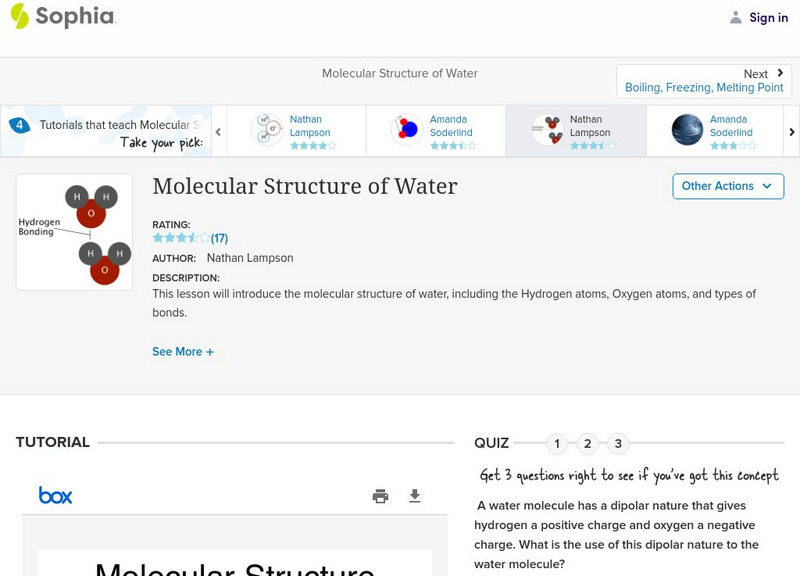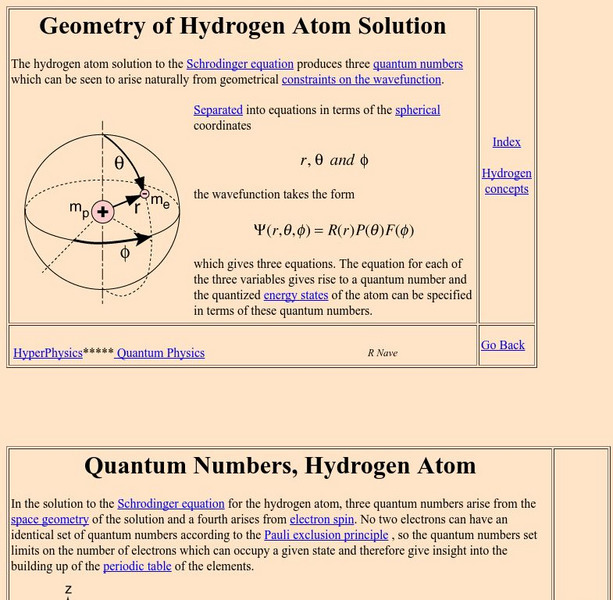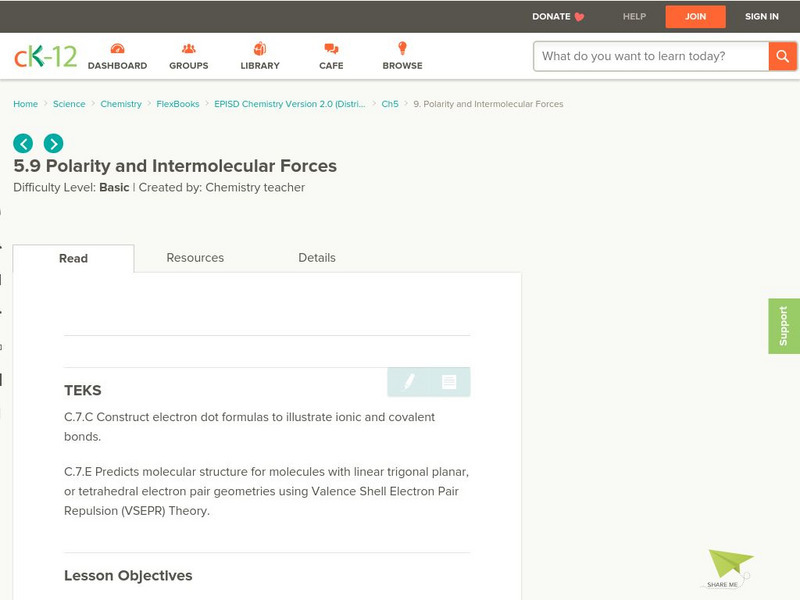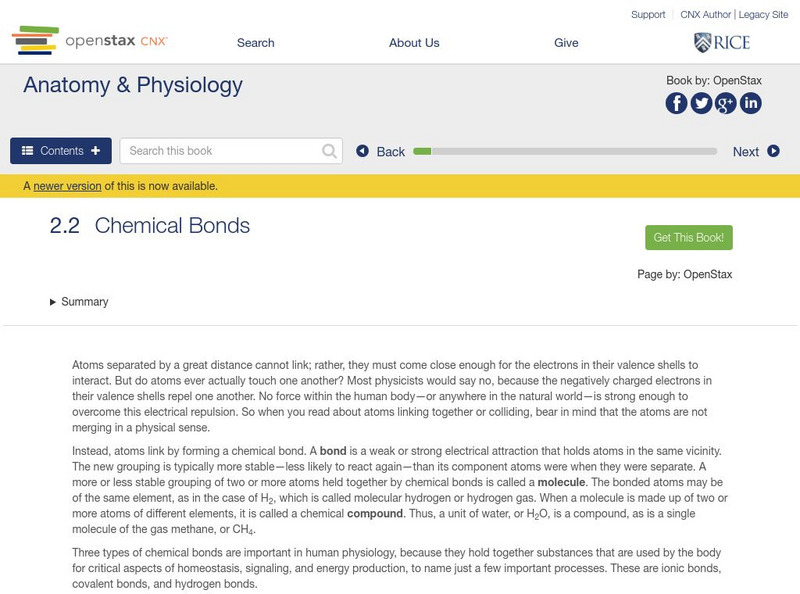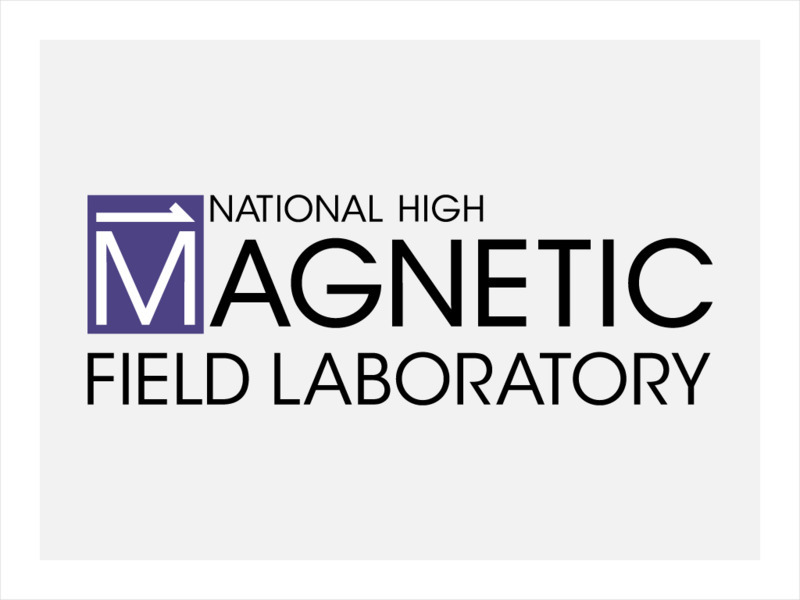Sophia Learning
Sophia: Molecular Structure of Water: Lesson 2
This lesson will introduce the molecular structure of water, including the Hydrogen atoms, Oxygen atoms, and types of bonds. It is 2 of 4 in the series titled "Molecular Structure of Water."
Sophia Learning
Sophia: Molecular Structure of Water: Lesson 3
This lesson will introduce the molecular structure of water, including the Hydrogen atoms, Oxygen atoms, and types of bonds. It is 3 of 4 in the series titled "Molecular Structure of Water."
Walter Fendt
Walter Fendt: Apps Zur Physik
This site, in German, offers numerous apps that illustrate common physics principles. Apps are organized into categories: mechanics, oscillations and waves, electrodynamics, optics, thermodynamics, the theory of relativity, physics of...
University Corporation for Atmospheric Research
Ucar: Hydrocarbons
Learn about "hydrocarbons", chemical compounds whose molecules are made up entirely of carbon and hydrogen atoms.
TED Talks
Ted: Ted Ed: How Polarity Makes Water Behave Strangely
Water is both essential and unique. Many of its particular qualities stem from the fact that it consists of two hydrogen atoms and one oxygen, therefore creating an unequal sharing of electrons. From fish in frozen lakes to ice floating...
Other
Atom Central: The Cuban Missile Crisis
A timeline of events between October 15 and November 1, 1963 depicts the time period during which the Cuban Missile Crisis took place,
Georgia State University
Georgia State University: Hyper Physics: Quantum Numbers, Hydrogen Atom
This tutorial contains links to explanations of the four different quantum numbers (principal, orbital, magnetic, and spin). Equations for each are provided.
Nobel Media AB
The Nobel Prize: The Nobel Prize in Chemistry 1934
At this website from The Nobel e-Museum, read about Harold Clayton Urey (1893-1981 CE), the chemist awarded with a Nobel Prize "for his discovery of heavy hydrogen." Download Urey's Nobel Lecture, "Some thermodynamic properties of...
CK-12 Foundation
Ck 12: Polarity and Intermolecular Forces
[Free Registration/Login may be required to access all resource tools.] The following online tutorial describes how the electronegativity difference between two atoms in a covalent bond results in the formation of a nonpolar covalent,...
Georgia Department of Education
Ga Virtual Learning: Ap Biology: Chemistry of Life
Through informational text, interactive activities, animations, and video clips, students examine the chemistry of living things, and they learn how interactions from atoms are fundamental to life as we know it.
OpenStax
Open Stax: Chemical Bonds
Learn here about chemical bonds, a weak or strong electrical attraction that holds atoms in the same vicinity.
University of St. Andrews (UK)
University of St. Andrews: Niels Henrik David Bohr
This resource presents a biography of Bohr, including many personal tidbits, as well as a substantial treatment of his scientific work. Several interesting quotes by and about Bohr are included. It also links to several other sources.
NASA
Nasa: Space Place: Play Helios: A Game About How the Sun Makes Energy!
In this pairing game, keep the Sun shining bright by matching up particles. Convert hydrogen atoms into helium atoms. This process is called nuclear fusion.
Encyclopedia of Earth
Encyclopedia of Earth: Solar Radiation
Almost all of the energy that drives the various systems (climate systems, ecosystems, hydrologic systems, etc.) found on the Earth originates from the sun. Solar energy is created at the core of the sun when hydrogen atoms are fused...
CK-12 Foundation
Ck 12: Chemistry: Bohr's Atomic Model
[Free Registration/Login may be required to access all resource tools.] Explains the basic principles of the Bohr hydrogen atom.
National High Magnetic Field Laboratory
Magnet Academy: Magnetic Resonance Imaging Mri
In MRI, magnetic fields and radio wave pulses combine to get a unique, and medically beneficial, response from your body's hydrogen atoms. Take a peek in this tutorial.
CK-12 Foundation
Ck 12: Plix: Carbohydrates: A Glucose Molecule
[Free Registration/Login Required] Drag the groups of hydroxy and hydrogen atoms to their proper locations to make a complete glucose molecule.
Concord Consortium
Concord Consortium: Nonbonding
Bring two molecules together and observe potential energy changes.
Ducksters
Ducksters: Chemistry for Kids: Isotopes
Study the science of isotopes in chemistry including naming isotopes, hydrogen, examples, fun facts, unstable, and stable on this site.
Curated OER
Simon Fraser University: Molecules and the Properties of Bonded Atoms
Drawing of a caffeine molecule. Hydrogen = white; Carbon = blue; Oxygen = red
Other
Fact index.com: Balmer Series
Fact-Index.com offers a brief dictionary definition of the Balmer series, including hyperlinked terms.
Other
Fact index.com: Paschen Series
Fact-Index.com offers a dictionary definition of the Paschen series, including hyperlinked terms.
PBS
Pbs: Nova: Illuminating Photosynthesis
To understand the process of photosynthesis, follow the hydrogen, carbon, and oxygen atoms as they travel between the air, the plant, and the soil.
OpenStax
Open Stax: Organic Compounds Essential to Human Functioning
Learn here about organic compounds, groups of carbon atoms covalently bonded to hydrogen, usually oxygen, and often other elements as well, and how they are essential to human functioning.

